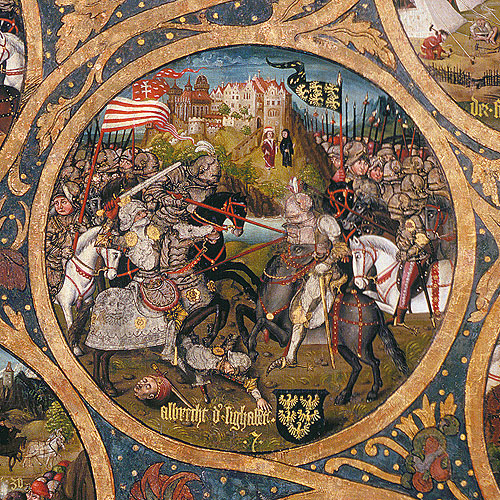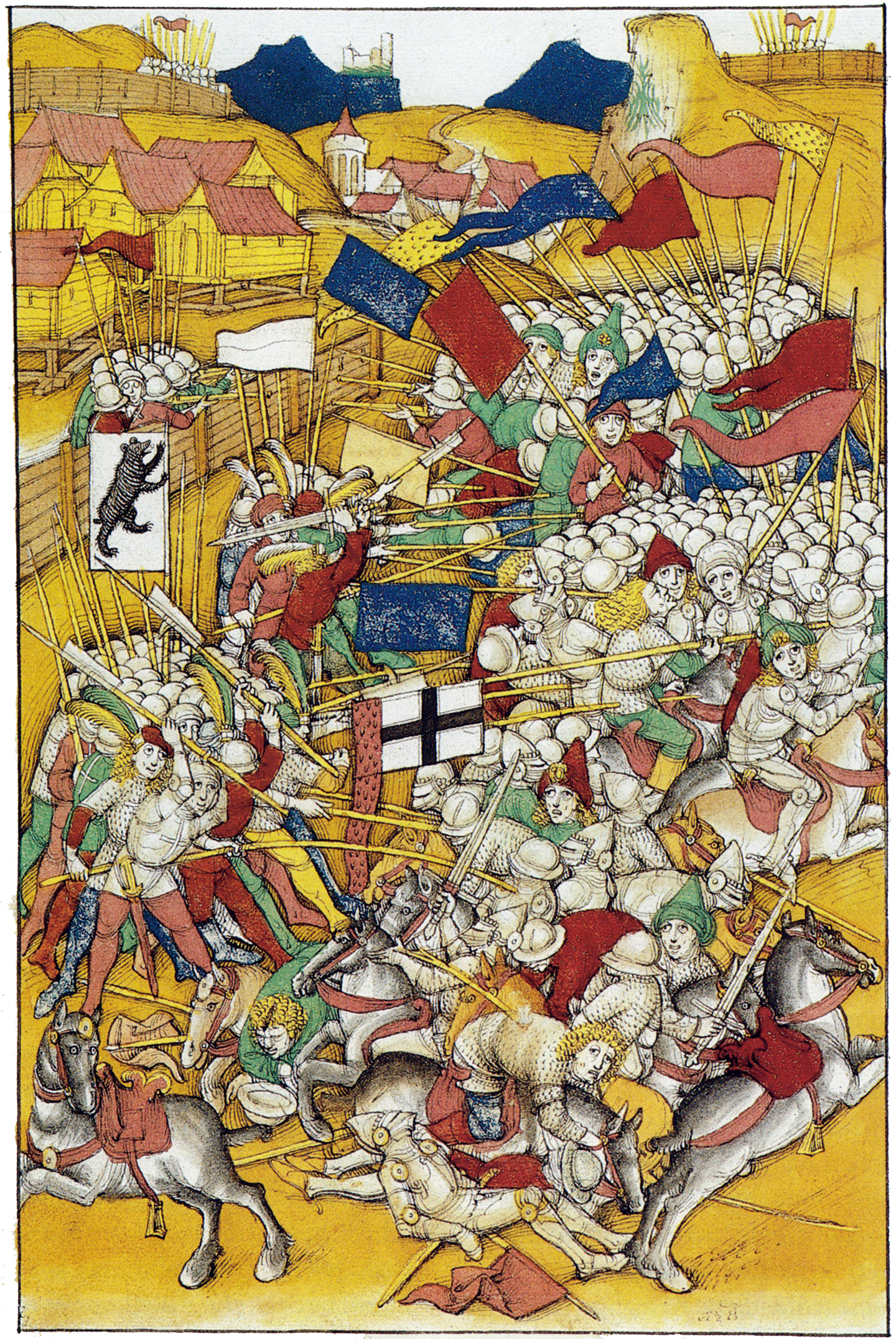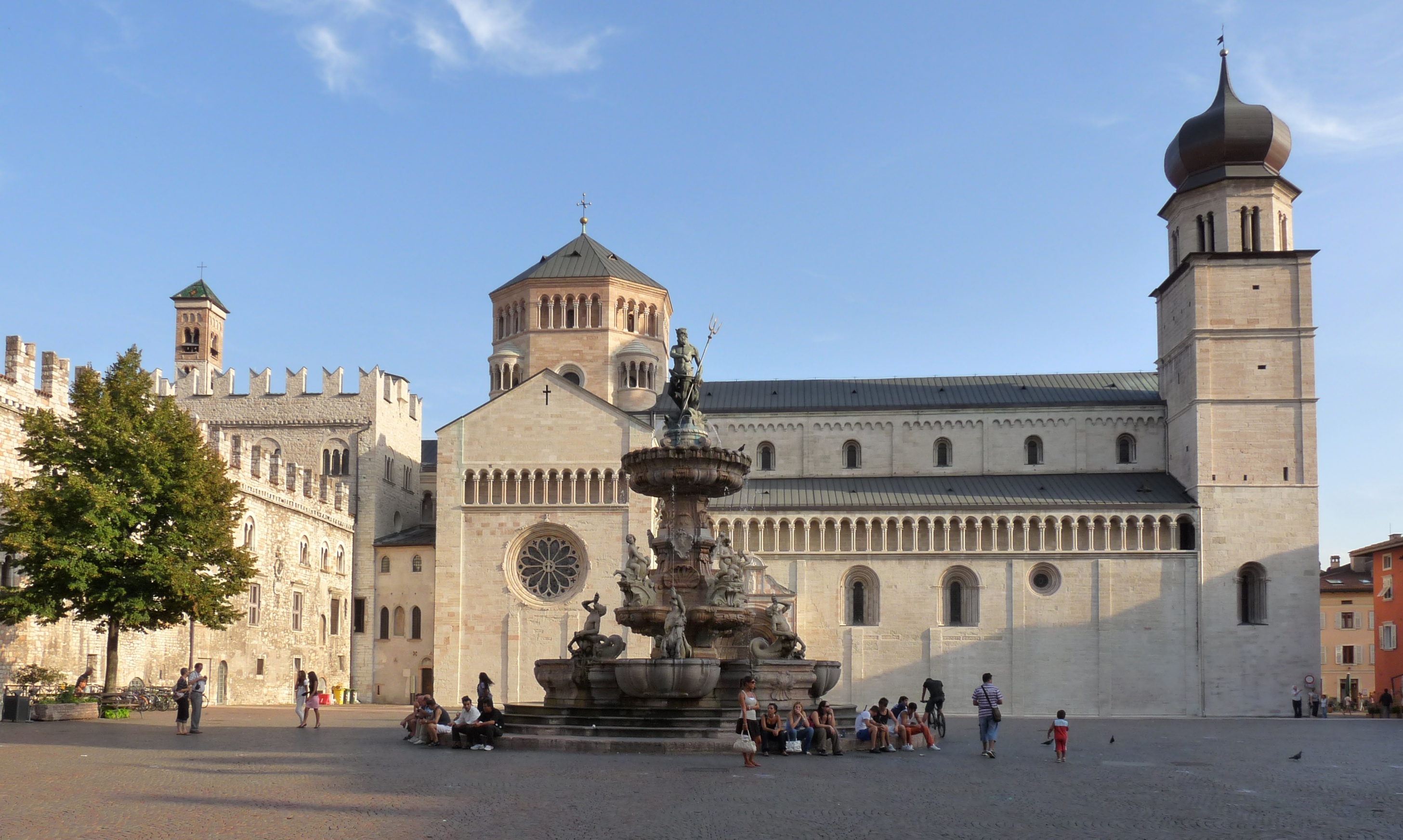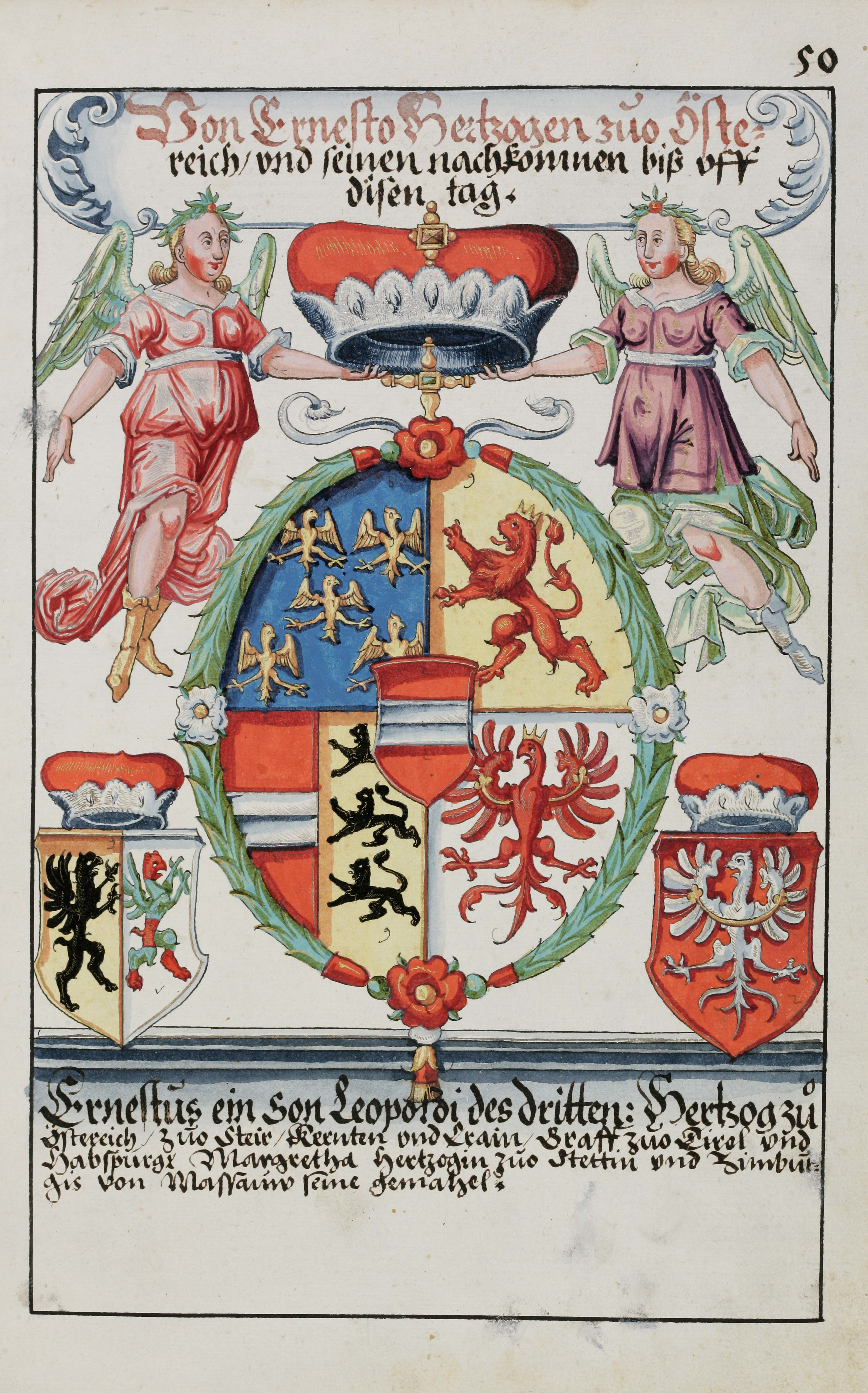|
Frederick IV Of Austria
Frederick IV (1382 – 24 June 1439), also known as Frederick of the Empty Pockets (german: Friedrich mit der leeren Tasche), a member of the House of Habsburg, was Duke of Austria from 1402 until his death. As a scion of the Habsburg Leopoldian line, he ruled over Further Austria and the County of Tyrol from 1406 onwards. Biography Frederick was the youngest son of Duke Leopold III (1351–1386) and his wife Viridis (d. 1414), a daughter of Bernabò Visconti, Lord of Milan. According to the 1379 Treaty of Neuberg, his father ruled over the Habsburg Inner Austrian territories of Styria, Carinthia, Carniola, as well as over Tyrol and the dynasty's original Further Austrian possessions in Swabia. After the early death of Duke Leopold in the 1386 Battle of Sempach, Frederick and his elder brothers William, Leopold IV and Ernest initially remained under the tutelage of their uncle Duke Albert III of Austria. As an inheritance dispute arose upon Duke Albert's death in 1395, the ... [...More Info...] [...Related Items...] OR: [Wikipedia] [Google] [Baidu] |
List Of Rulers Of Austria
This is a list of people who have ruled either the Margraviate of Austria, the Duchy of Austria or the Archduchy of Austria. From 976 until 1246, the margraviate and its successor, the duchy, was ruled by the House of Babenberg. At that time, those states were part of the Holy Roman Empire. From 1246 until 1918, the duchy and its successor, the archduchy, was ruled by the House of Habsburg. Following the defeat of Austria-Hungary in World War I, the titles were abolished or fell into abeyance with the erection of the modern Republic of Austria. Margraves of Austria The March of Austria, also known as ''Marcha Orientalis'', was first formed in 976 out of the lands that had once been the March of Pannonia in Carolingian times. The oldest attestation dates back to 996, where the written name "ostarrichi" occurs in a document transferring land in present-day Austria to a Bavarian monastery. House of Babenberg , width=auto, Leopold I the Illustrious(''Luitpold der Erlauchte'')976� ... [...More Info...] [...Related Items...] OR: [Wikipedia] [Google] [Baidu] |
Duchy Of Carniola
The Duchy of Carniola ( sl, Vojvodina Kranjska, german: Herzogtum Krain, hu, Krajna) was an imperial estate of the Holy Roman Empire, established under House of Habsburg, Habsburg rule on the territory of the former East Frankish March of Carniola in 1364. A hereditary land of the Habsburg monarchy, it became a constituent land of the Austrian Empire in 1804 and part of the Kingdom of Illyria (1816–1849), Kingdom of Illyria until 1849. A separate crown land from 1849, it was incorporated into the Cisleithanian territories of Austria-Hungary from 1867 until the state's dissolution in 1918. Its capital was Ljubljana (german: Laibach). Geography The borders of the historic Carniola region had varied over the centuries. From the time of the duchy's establishment, it was located in the southeastern periphery of the Holy Roman Empire, where the Žumberak, Gorjanci Mountains and the Kupa, Kolpa River formed the border with the Kingdom of Croatia (other), Kingdom of Croatia. ... [...More Info...] [...Related Items...] OR: [Wikipedia] [Google] [Baidu] |
Stephen III, Duke Of Bavaria
Stephen III (1337 – 26 September 1413), called the Magnificent or the Fop (''Stephan der Kneißl''), was the Duke of Bavaria-Ingolstadt from 1375. He was the eldest son of Stephen II and Elizabeth of Sicily. Family His maternal grandparents were Frederick III of Sicily and Eleanor of Anjou, the daughter of Charles II of Naples and Maria Arpad of Hungary. Maria was a daughter of Stephen V of Hungary and his wife, queen Elisabeth, who was daughter of Zayhan of Kuni, a chief of the Cuman tribe and had been a pagan before her marriage. Stephen V was a son of Béla IV of Hungary and Maria Laskarina. Maria Laskarina was a daughter of Theodore I Lascaris and Anna Angelina. Anna was daughter of Eastern Roman Emperor Alexius III and Euphrosyne Doukaina Kamaterina. Reign From 1375 to 1392, Stephen ruled Bavaria with his brothers Frederick and John II. However, in 1392, Bavaria was split into three separate Duchies, now consisting of Bavaria-Landshut, Bavaria-Ingolstadt and Bavaria-M ... [...More Info...] [...Related Items...] OR: [Wikipedia] [Google] [Baidu] |
Old Swiss Confederacy
The Old Swiss Confederacy or Swiss Confederacy (German language, Modern German: ; historically , after the Swiss Reformation, Reformation also , "Confederation of the Swiss") was a loose confederation of independent small states (, German or In the charters of the 14th century described as "communities" (, ), the German term ''Orte'' becomes common in the early 15th century, used alongside "estate" after the Reformation. The French term is used in Fribourg in 1475, and after 1490 is increasingly used in French and Italian documents. It only enters occasional German usage after 1648, and only gains official status as synonym of with the Act of Mediation of 1803. ), initially within the Holy Roman Empire. It is the precursor of the modern state of Switzerland. It formed during the 14th century, from a foundation of the Old Swiss Confederacy, nucleus in what is now Central Switzerland, growth of the Old Swiss Confederacy, expanding to include the cities of Zürich and Bern by ... [...More Info...] [...Related Items...] OR: [Wikipedia] [Google] [Baidu] |
Appenzell Wars
The Appenzell Wars (german: Appenzeller Kriege) were a series of conflicts that lasted from 1401 until 1429 in the Appenzell region of modern-day Switzerland. The wars consisted of uprisings of cooperative groups, such as the farmers of Appenzell or the craftsmen of the city of St. Gallen, against the traditional medieval power structure represented by the House of Habsburg and the Prince-Abbot of the Abbey of St. Gall. The conflict was one of a number of popular revolts in late-medieval Europe. It resulted in greater autonomy for Appenzell and its association with the Old Swiss Confederacy, of which it would become a member ( canton) in 1513. Background Appenzell (the name in la, abbatis cella means "cell (i.e. estate) of the abbot") had been under the personal control of the abbot of St. Gall. While the Prince-Abbot appointed agents or bailiffs, the communities in Appenzell were governed by a council appointed by the ''Landsgemeinde'', in which every citizen could vote. The ... [...More Info...] [...Related Items...] OR: [Wikipedia] [Google] [Baidu] |
Abbey Of Saint Gall
The Abbey of Saint Gall (german: Abtei St. Gallen) is a dissolved abbey (747–1805) in a Catholic religious complex in the city of St. Gallen in Switzerland. The Carolingian-era monastery existed from 719, founded by Saint Othmar on the spot where Gallus had erected his hermitage. It became an independent principality between 9th and 13th centuries, and was for many centuries one of the chief Benedictine abbeys in Europe. The library of the Abbey is one of the oldest monastic libraries in the world. The city of St. Gallen originated as an adjoining settlement of the abbey. The abbey was secularized around 1800, and in 1848 its former church became a Cathedral. Since 1983 the abbey precinct has been a UNESCO World Heritage Site. History Foundation Around 612 Gallus, according to tradition an Irish monk and disciple and companion of Saint Columbanus, established a hermitage on the site that would become the monastery. He lived in his cell until his death in 646, and wa ... [...More Info...] [...Related Items...] OR: [Wikipedia] [Google] [Baidu] |
Appenzell
Appenzell is a historic canton in the northeast of Switzerland, and entirely surrounded by the canton of St. Gallen. Appenzell became independent of the Abbey of Saint Gall in 1403 and entered a league with the Old Swiss Confederacy in 1411, becoming a full member in 1513. It has been divided since into Appenzell Innerrhoden and Appenzell Ausserrhoden since 1597 as a result of the Swiss Reformation. The territory of Appenzell as a geographical entity is known as ''Appenzellerland'' while in political contexts, the two cantons (until 1999 half-cantons) are referred to as ''beide Appenzell'' ("both Appenzells"). History Foundation The name ''Appenzell'' derives from la, abbatis cella 'cell (i.e., estate) of the abbot'. This refers to the Abbey of St. Gall, which exerted a great influence on the area. By the middle of the 11th century the abbots of St Gall had established their power in the land later called Appenzell, which by that time was thoroughly Alemannic. By ab ... [...More Info...] [...Related Items...] OR: [Wikipedia] [Google] [Baidu] |
Prince-Bishopric Of Trent
The Prince-Bishopric of Trent ( la, Episcopatus ac Principatus Tridentinus; german: Hochstift Trient, Fürstbistum Trient, Bistum Trient) was an ecclesiastical principality roughly corresponding to the present-day Northern Italian autonomous province of Trentino. It was created in 1027 and existed until 1802, when it was secularised and absorbed into the County of Tyrol held by the House of Habsburg. Trent was a ''Hochstift'', an Imperial State under the authority of a prince-bishop at Trento. History Middle Ages A first Bishop of Trent is recorded as a participant of the synod at Aquileia in 381. The area was part of the Lombard Kingdom and the Kingdom of Italy, until the 951 campaign of German king Otto I against King Berengar II of Italy. In 952 Berengar had to cede the March of Verona to Otto, who enfeoffed his younger brother Duke Henry I of Bavaria. From 1004 Emperor Henry II the Saint and his successor Conrad II separated several smaller territories in the northea ... [...More Info...] [...Related Items...] OR: [Wikipedia] [Google] [Baidu] |
Freiburg Im Breisgau
Freiburg im Breisgau (; abbreviated as Freiburg i. Br. or Freiburg i. B.; Low Alemannic German, Low Alemannic: ''Friburg im Brisgau''), commonly referred to as Freiburg, is an independent city in Baden-Württemberg, Germany. With a population of about 230,000 (as of 31 December 2018), Freiburg is the List of cities in Baden-Württemberg by population, fourth-largest city in Baden-Württemberg after Stuttgart, Mannheim, and Karlsruhe. The population of the Freiburg metropolitan area was 656,753 in 2018. In the Southern Germany, south-west of the country, it straddles the Dreisam river, at the foot of the Schlossberg (Freiburg), Schlossberg. Historically, the city has acted as the hub of the Breisgau region on the western edge of the Black Forest in the Upper Rhine Plain. A famous old German university town, and Roman Catholic Archdiocese of Freiburg, archiepiscopal seat, Freiburg was incorporated in the early twelfth century and developed into a major commercial, intellectual, an ... [...More Info...] [...Related Items...] OR: [Wikipedia] [Google] [Baidu] |
Albert III, Duke Of Austria
Albert III of Austria (9 September 1349 – 29 August 1395), known as Albert with the Braid (Pigtail) (german: Albrecht mit dem Zopf), a member of the House of Habsburg, was Duke of Austria from 1365 until his death. Biography Albert III was born in the ducal residence of Vienna, the third son of the Habsburg duke Albert II of Austria and his wife Joanna of Pfirt. Even though his father had determined a house law, whereby the four sons were obliged to rule jointly and equally, the eldest brother Rudolf IV assumed the reins of government after his father's death in 1358. He reaffirmed his supremacy issuing the ''Privilegium Maius''. However, as his marriage remained childless he again had to share his power with his younger brothers. In 1365 Rudolf IV, Albert III, and Leopold III together signed the foundation certificate of the Vienna University (''Alma Mater Rudolphina Vindobonensis''); Rudolf died a few months later at the age of 25. Divided rule Albert, then the eldest s ... [...More Info...] [...Related Items...] OR: [Wikipedia] [Google] [Baidu] |
Ernest, Duke Of Austria
Ernest the Iron (; 1377 – 10 June 1424), a member of the House of Habsburg, ruled over the Inner Austrian duchies of Styria, Carinthia and Carniola from 1406 until his death. He was head of the Habsburg Leopoldian line from 1411. Biography Ernest was born in Bruck an der Mur in Styria, the third son of Duke Leopold III of Austria (1351–1386) and his consort Viridis Visconti (d. 1414), a daughter of Bernabò Visconti, Lord of Milan. Shortly after his birth, his father and his uncle Albert III divided the Habsburg lands by the 1379 Treaty of Neuberg: while Albert and his Albertinian descendants would rule over the Duchy of Austria The Duchy of Austria (german: Herzogtum Österreich) was a medieval principality of the Holy Roman Empire, established in 1156 by the ''Privilegium Minus'', when the Margraviate of Austria (''Ostarrîchi'') was detached from Bavaria and elevated ... proper, the Leopoldian line received the Inner Austrian Imperial state, states of Styria, ... [...More Info...] [...Related Items...] OR: [Wikipedia] [Google] [Baidu] |
Leopold IV, Duke Of Austria
Leopold IV of Austria (1371 – June 3, 1411), Duke of Further Austria, was an Austrian Habsburg Duke of the ''Leopoldinian Line'', known as "the Fat". Biography He was the second son of Leopold III. His eldest brother Duke William of Inner Austria took him as his effective co-ruler, putting him in particular charge of Further Austria, which also meant ancestral Habsburg lands in Swiss Aargau etc. Leopold was to face Swiss opposition to Austrian administration. From 1391 onwards, he was the effective ruler of Further Austria, and from 1396 to 1406 he was ruler in Tyrol too. He married Catherine de Valois of Burgundy, daughter of Philip II, Duke of Burgundy, in 1393. She died in 1425, and they had no surviving children. His younger brothers Ernest the Iron and Frederick were, for the time being, left to grow up. They were initiated with ducal positions in 1402. In 1406 their eldest brother Duke William died without leaving heirs, and Leopold became the next head of thei ... [...More Info...] [...Related Items...] OR: [Wikipedia] [Google] [Baidu] |








_4029.jpg)


